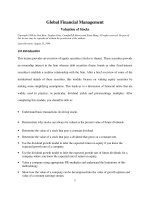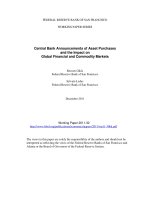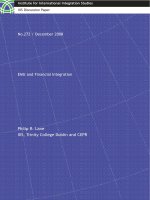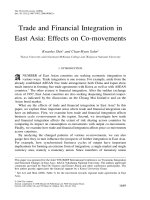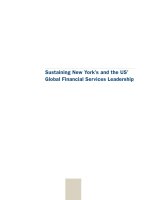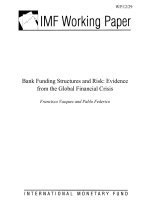underhill - global financial integration thirty years on; from reform to crisis (2010)
Bạn đang xem bản rút gọn của tài liệu. Xem và tải ngay bản đầy đủ của tài liệu tại đây (2.05 MB, 376 trang )
This page intentionally left blank
Global Financial Integration Thirty Years On
Early in the new millennium it appeared that a long period of finan-
cial crisis had come to an end, but the world now faces renewed
and greater turmoil. This volume analyses the past three decades
of global financial integration and governance and the recent col-
lapse into crisis, offering a coherent and policy-relevant overview.
State-of-the-art research from an interdisciplinary group of scholars
illuminates the economic, political and social issues at the heart of
devising an effective and legitimate financial system for the future.
The chapters offer debate around a series of core themes which probe
the ties between public and private actors and their consequences for
outcomes for both developed markets and developing countries alike.
The contributors argue that developing effective, legitimate finan-
cial governance requires enhancing public versus private authority
through broader stakeholder representation, ensuring more accept-
able policy outcomes.
g e o f f r e y r . d. u n d e r h i l l is Chair in International Gover-
nance in the Department of Political Science at the University of
Amsterdam.
j a s p e r b l o m is a Ph.D. candidate at the Amsterdam Institute for
Social Science Research, University of Amsterdam.
d a n i e l m ü g g e is Assistant Professor of International Political
Economy in the Department of Political Science at the University of
Amsterdam.
Global Financial Integration
Thirty Years On
From Reform to Crisis
Geoffrey R. D. Underhill
University of Amsterdam
Jasper Blom
University of Amsterdam
Daniel Mügge
University of Amsterdam
Edited by
c a m b r i d g e u n i v e r s i t y p r e s s
Cambridge, New York, Melbourne, Madrid, Cape Town, Singapore,
São Paulo, Delhi, Dubai, Tokyo, Mexico City
Cambridge University Press
The Edinburgh Building, Cambridge CB2 8RU, UK
Published in the United States of America by Cambridge University Press, New York
www.cambridge.org
Information on this title: www.cambridge.org/9780521198691
© Cambridge University Press 2010
This publication is in copyright. Subject to statutory exception
and to the provisions of relevant collective licensing agreements,
no reproduction of any part may take place without the written
permission of Cambridge University Press.
First published 2010
Printed in the United Kingdom at the University Press, Cambridge
A catalogue record for this publication is available from the British Library
Library of Congress Cataloguing in Publication data
Global financial integration thirty years on : from reform to crisis /
[edited by] Geoffrey R.D. Underhill, Jasper Blom, Daniel Mügge.
p. cm.
Includes bibliographical references and index.
ISBN 978-0-521-19869-1
1. International finance. 2. International economic integration.
3. Financial crises–History–21st century. I. Underhill, Geoffrey R. D.
II. Blom, Jasper, 1978– III. Mügge, Daniel. IV. Title.
HG3881.G5737 2010
332′.042–dc22
2010021892
ISBN 978-0-521-19869-1 Hardback
Cambridge University Press has no responsibility for the persistence or
accuracy of URLs for external or third-party internet websites referred to in
this publication, and does not guarantee that any content on such websites is,
or will remain, accurate or appropriate.
v
List of gures page viii
List of tables x
Notes on contributors xi
Preface xiii
Acknowledgements xv
List of abbreviations xvii
Introduction: the challenges and prospects of global
financial integration 1
g e o f f r e y r. d . u n d e r h i l l , j a s p e r b l o m a n d
d a n i e l m ü g g e
Part I History and context: input, output and the
current architecture (whence it came) 23
1 Financial governance in historical perspective: lessons
from the 1920s 25
r a n d a l l g e r m a i n
2 Between the storms: patterns in global financial governance,
2001–2007 42
e r i c h e l l e i n e r a n d s t e f a n o p a g l i a r i
3 Deliberative international financial governance and apex
policy forums: where we are and where we should be headed 58
a n d r e w b a k e r
4 Finance, globalisation and economic development: the
role of institutions 74
d a n n y c a s s i m o n , p a n i c o s d e m e t r i a d e s a n d
b j ö r n v a n c a m p e n h o u t
Contents
Contentsvi
Part II Assessing the current nancial architecture
(how well does it work?) 93
5 Adopting international financial standards in Asia:
convergence or divergence in the global political economy? 95
a n d r e w w a l t e r
6 The political economy of Basel II in the international
financial architecture 113
s t i j n c l a e s s e n s a n d g e o f f r e y r . d . u n d e r h i l l
7 The catalytic approach to debt workout in practice:
coordination failure between the IMF, the Paris Club
and official creditors 134
e e l k e d e j o n g a n d k o e n v a n d e r v e e r
8 Empirical evidence on the new international aid architecture 150
s t i j n c l a e s s e n s , d a n n y c a s s i m o n a n d b j ö r n v a n
c a m p e n h o u t
9 Who governs and why? The making of a global anti-money
laundering regime 172
e l e n i t s i n g o u
10 Brazil and Argentina in the global financial system:
contrasting approaches to development and foreign debt 187
v i c t o r k l a g s b r u n n
11 Global markets, national alliances and financial
transformations in East Asia 204
x i a o k e z h a n g
Part III Does the future hold? Reactions to the current
regime and prospects for progress (where is it going?) 221
12 Changing transatlantic financial regulatory relations at the
turn of the millennium 223
e l l i o t p o s n e r
13 Monetary and financial cooperation in Asia: improving
legitimacy and effectiveness? 241
h e r i b e r t d i e t e r
14 From microcredit to microfinance to inclusive finance:
a response to global financial openness 256
b r i g i t t e y o u n g
Contents vii
15 Combating pro-cyclicality in the international financial
architecture: towards development-friendly financial
governance 270
j o s é o c a m p o a n d s t e p h a n y g r i f f i t h -j o n e s
16 Public interest, national diversity and global financial
governance 287
g e o f f r e y r. d . u n d e r h i l l a n d x i a o k e z h a n g
Conclusion: whither global financial governance
after the crisis? 304
d a n i e l m ü g g e , j a s p e r b l o m a n d
g e o f f r e y r. d . u n d e r h i l l
References 316
Index 347
viii
3.1 Continuum of deliberative equality page 71
4.1 The complex dynamics of financial globalisation 83
4.2 (Appendix) Recursion diagram 90
5.1 The spectrum of compliance 99
5.2 Private sector compliance costs and third-party
monitoring costs for different international standards 107
6.1 Number of countries which have a positive, neutral or
negative spread change due to Basel II 128
6.2 Average spread change in basis points under Basel II 129
6.3 Internal and external ratings in the East Asian
financial crisis 131
7.1 Estimating a country’s financing gap 137
8.1 Bilateral net ODA transfers, 1970–2006 154
8.2 Responsiveness of aid to countries’ income, policy,
population and debt 159
8.3 Time-varying, donor-specific sensitivities for CPIA 161
8.4 Time-varying, donor-specific sensitivities for GDP 162
8.5 Time-varying, donor-specific sensitivities for
population size 163
8.6 Time-varying, donor-specific sensitivities for debt
outstanding disbursed 164
10.1 Current account balance as % of GDP 190
10.2 Trade balance selected developing countries in
US$ billions – I 190
10.3 Trade balance selected developing countries in
US$ billions – II 191
10.4 Effective real exchange rates 192
10.5 Brazil: international total reserves, total external debt
and net external debt 198
10.6 Argentina: total external debt, 1995–2007 200
10.7 EMBI spread Argentina vs. global, 1998–2007 201
Figures
List of figures ix
10.8 EMBI spread Brazil vs. global, 1998–2007 201
14.1 Accessing financial markets: progressive stages for MFIs 266
15.1 Emerging market spreads on JP Morgan EMBI
global and US high-yield bonds 274
x
4.1 Evolution of external flows to Sub-Saharan Africa and to
other developing countries page 81
5.1 Formal compliance with SDDS, IFRS and Basel I
standards 98
5.2 Moody’s weighted average long-term deposit ratings,
bank financial strength ratings and average CARs,
Asian and US banks, 2003 109
7.1 Official lending in countries with an IMF programme 141
7.2 Official financing and the catalytic effect of IMF
programmes 142
8.1 Overview of the paradigm changes in the international
aid architecture 152
8.2 Monitoring the Paris Declaration commitments: 2005
baseline and 2010 targets 165
8.3 Measures of aid quality and governance of bilateral
donors 166
8.4 (Appendix) Fixed effects, random effects and Hausman-
Taylor estimations 171
10.1 Brazil: external debt of central government 199
12.1 Empirical expectations of regulatory centralisation
explanation 228
12.2 Transatlantic dispute management over time – the
turning points 229
12.3 Transatlantic dispute management over time – EU
centralisation 234
13.1 Total reserves minus gold of selected Asian economies 246
Tables
xi
a n d r e w b a k e r is Senior Lecturer in political economy at the School
of Politics, International Studies and Philosophy, Queen’s University,
Belfast
j a s p e r b l o m is a Ph.D. candidate at the Amsterdam Institute for Social
Science Research, University of Amsterdam
b j ö r n v a n c a m p e n h o u t is a researcher assistant at the Institute of
Development Policy and Management, University of Antwerp
d a n n y c a s s i m o n is Senior Lecturer at the Institute of Development
Policy and Management, University of Antwerp
s t i j n c l a e s s e n s is Assistant Director of the Research Department at the
International Monetary Fund and Professor of International Finance
Policy at the Faculty of Economics, University of Amsterdam
p a n i c o s d e m e t r i a d e s is Professor of Financial Economics at the
Department of Economics, University of Leicester
h e r i b e r t d i e t e r is Senior Fellow at the German Institute for
International and Security Affairs and Associate Fellow at the Centre
for the Study of Globalisation and Regionalisation at Warwick
University
r a n d a l l g e r m a i n is Professor of Political Science at the Department
of Political Science, Carleton University
s t e p h a n y g r i f f i t h -j o n e s is Director of the Financial Markets
Programme at the Institute for Policy Dialogue, Columbia University
e r i c h e l l e i n e r is Professor, Department of Political Science,
University of Waterloo
e e l k e d e j o n g is Professor of International Economics at the Nijmegen
School of Management, Radboud University Nijmegen
Contributors
Notes on contributorsxii
v i c t o r k l a g s b r u n n is Professor of Economics at the Department of
Economics, Fluminense Federal University, São Paolo, Brazil
d a n i e l m ü g g e is Assistant Professor of International Political Economy
at the Department of Political Science, University of Amsterdam
j o s é o c a m p o is Professor in the Professional Practice of International
and Public Affairs at the School of International and Public Affairs,
Columbia University
s t e f a n o p a g l i a r i is a Ph.D. candidate in the Global Governance
programme at the Balsillie School of International Affairs, University
of Waterloo
e l l i o t p o s n e r is Assistant Professor of Political Science at the
Department of Political Science, Case Western Reserve University
e l e n i t s i n g o u is Research Fellow at the Centre for the Study of
Globalisation and Regionalisation, University of Warwick
g e o f f r e y r. d . u n d e r h i l l is Chair in International Governance at
the Department of Political Science, University of Amsterdam
k o e n v a n d e r v e e r is a researcher at De Nederlandsche Bank and a
Ph.D. candidate at the Department of Economics, Radboud University
Nijmegen
a n d r e w w a l t e r is Reader in International Political Economy at the
Department of International Relations, London School of Economics
and Political Science
b r i g i t t e y o u n g is Professor of Political Science and International/
Comparative Political Economy at the Institute for Political Science,
University of Münster
x i a o k e z h a n g is Associate Professor in Political Economy and Asian
Studies at the School of Politics and International Relations, University
of Nottingham
xiii
Producing a volume on financial governance just at the outbreak of
the worst financial crisis since the Great Depression proved to be both
a daunting and exciting task. While the onset of crisis raised the sali-
ence of work on financial governance considerably, both editors and
contributors might be forgiven for a sense of exhaustion related to the
hot pursuit of a moving target. This has meant that the purpose of
the volume has evolved rather rapidly over the past three years. The
volume began life as an analysis of the record and historical experi-
ence of the ‘new international financial architecture’ developed in the
wake of the emerging market crises of the 1990s and early 2000s. The
analysis yielded the conclusion that not all was functioning as effect-
ively as the architects believed. The aim was to challenge the apparent
complacency of the period of calm following the Argentine default, and
to stimulate new thinking based on the understanding and reading of
the evidence that all was not well and that fundamental flaws in global
financial governance required urgent attention.
By August 2007, when an early version of the manuscript was ready
and much of the research findings had been discussed in workshops,
it became clear that the usual crisis rumblings but of unusual force
were beginning deep below the fine edifice constructed by the archi-
tects. There was much discussion of these rumblings at a workshop
devoted to the second full draft of the volume which assembled the
contributors in Venice in May 2008, a sense of foreboding but not yet
real understanding of what lay ahead. By the end of the summer 2008
the sense of foreboding had certainly increased as the manuscript was
submitted for review. By early October the entire picture had changed
so dramatic ally that the new circumstances raised questions about the
viability of the project and the relevance of the manuscript to the rap-
idly evolving situation. The edifice of global finance had been brought
down and the world was on the way to devoting an unprecedented ratio
of annual GDP to rescuing the banks. By this time our tentative conclu-
sion that something was amiss was clearly a no-brainer and we and the
Preface
Prefacexiv
contributors wondered what on earth would happen next to the finan-
cial world and to our volume. As editors we chose path dependency and
soldiered on.
We would like to thank one of the anonymous reviewers in particular
for the encouraging and confident assessment that we did indeed have a
story to tell and that the research which found its way into the chapters
remained relevant if in obvious need of updating. The result must be
judged by the reader, but we believe we have succeeded in adapting and
updating the analysis and research findings of the chapters to yield an
explanation of how the reforms which were the new financial architec-
ture became an integral part of the problem which led to the outbreak
of crisis. The contributions do so on a particularly broad scale, and our
thanks to Cambridge University Press for supporting a project of such
scope in this era of sound bites, summaries and opinionated blogging.
In this sense the volume is no straightforward look at the usual sus-
pects in global financial markets and their governance, although these
are there. This volume provides comprehensive coverage of the inter-
national financial system and its governance, from microfinance and
aid architecture in relation to poverty relief and the problems of under-
development, to the money-laundering regime to the supervision of the
world’s most sophisticated and largest (and many still fragile) financial
institutions. The volume provides a launch pad for debate and discus-
sion of what should be done and in which direction the reform process
should proceed, all based on original research by an interdisciplinary
set of authors conscious of our shared critical yet constructive purpose.
The volume begins with historical context and looks at the aims of
financial reform in the 1990s through to the period of calm before the
current crisis. The analysis of what was wrong with the new financial
architecture is then employed to develop ideas on where reform should
now be headed. In this sense the volume provides an interdisciplin-
ary guide to the origins of the crisis and the governance issues which
the post-crisis reform process must address. There had emerged over
time a vision of market-based governance shared by the public and pri-
vate sectors in international finance which failed to prevent the current
calamity and to provide a financial order compatible with basic stabil-
ity. These problems were far from resolved at the time of writing and
it is not clear that sufficient political will exists to realise the necessary
change going forward.
xv
Acknowledgements
It is with great pleasure that we acknowledge those who have sup-
ported us in this project over the past three years. Our first and great-
est debt is to the excellence of our contributors and their loyalty and
patience in sticking with the effort to send the book to press. A few
of the scholars who contribute to this volume first came into regular
contact with each other many years ago, but a particular impetus in
terms of original research findings was given to the project by the fund-
ing provided by the Economic and Research Council of the UK under
its World Economy and Finance research programme. From 2005 it
funded a project headed by Panicos Demetriades at the University of
Leicester and including as partners the London School of Economics
and Political Science and the University of Amsterdam (‘National and
International Aspects of Financial Development’, award no. RES-156-
25-0009). The regular series of workshops organised by Panicos and
his team at Leicester were invaluable in terms of establishing working
relationships across disciplinary boundaries and building confidence
and collegiality among a number of the contributors presented here.
Further impetus was given by the European Commission’s Framework
Six research programme, which funded a major network of excellence
also beginning in 2005 (GARNET, award no. 513330), headed by the
University of Warwick with over forty partners across Europe. The con-
tacts developed through the work package on global economic govern-
ance and market regulation (the coordination of which was shared by
Geoffrey R. D. Underhill and Heribert Dieter) have proven invaluable.
Once again a series of successful cross-disciplinary workshops brought
scholars and policy practitioners together, directly contributing to some
of the research found in these pages and particularly to connecting them
to each other. GARNET funding in particular financed the May 2008
workshop in Venice, at the University of Warwick’s Palazzo Pesaro-
Papafava there, the workshop which yielded the second full draft of
the manuscript and set it on course for peer review and publication. A
final push was facilitated by yet another EU research grant, this time
Acknowledgementsxvi
under the Framework Seven programme project PEGGED (Political
and Economic Governance: the Global and European Dimensions,
award no. SSH7-CT-2008-217559) and which began in the summer
of 2008. Our research institute at the University of Amsterdam, the
venerable Amsterdam School for Social Science Research (ASSR), pro-
vided logistical support and inspirational colleagues who participated
and inspired us in this project. Our thanks go in particular to José
Komen who manages the school so well. The School also financed four
years of Ph.D. research for Daniel Mügge, now assistant professor at
the Department of Political Science, hosted and financed workshops,
and funded much occasional conference and other research-related
travel over the years. Research funding for Jasper Blom was provided
by the Netherlands Organisation for Scientific Research (NWO, grant
no. 400-04-233), funding without which his contribution would not
have been possible and then neither would this book. We are also grate-
ful to De Nederlandsche Bank (central bank of the Netherlands), in
particular Jan Brockmeijer who was long head of the Financial Stability
Department and now fills the same function at the IMF, for its sup-
port for the major 2006 conference ‘Global Financial and Monetary
Governance: the EU and Emerging Market Economies’, and for keep-
ing us in touch with the real world of financial governance. No doubt
these acknowledgements have left someone out but we have done our
best to cover the considerable ground required in expressing our heart-
felt thanks.
We leave it to the reader to judge the result. Any remaining weak-
nesses in the final product are ours alone.
xvii
ABF Asian Bond Fund
ABMI Asian Bond Market Initiative
AMF Asian Monetary Fund
AML Anti-Money Laundering
AREAER Annual Report on Exchange Arrangements and
Exchange Restrictions (IMF)
ASEAN Association of South-East Asian Nations
B-I Basel I (capital accord)
B-II Basel II (capital accord)
BC Basel Committee on Banking Supervision
BCP Basel Core Principles for Effective Banking Supervision
BFSR Bank Financial Strength Ratings (Moody’s Investor
Services)
BIS Bank for International Settlements
CAC Collective Action Clause
CAR Capital to risk-weighted Assets Ratio (Capital Adequacy
Ratio)
CCL Contingent Credit Line (IMF)
CDI Commitment to Development Index (Center for Global
Development)
CDO Collateralised Debt Obligation
CESR Committee of European Securities Regulators
CFF Compensatory Financial Facility (IMF)
CFT Combating the Financing of Terrorism
CFTC Commodities Futures Trading Commission
CMI Chiang Mai Initiative
CPIA Country Policy and Institutional Assessment (World
Bank)
DAC Development Assistance Committee (OECD)
Abbreviations
List of abbreviationsxviii
DPP Democratic Progressive Party (Taiwan)
EC European Commission
ECA Export Credit Agency
ECU European Currency Unit
EEA Exchange Equalization Account (UK)
EFF Extended Fund Facility (IMF)
EMEAP Executives’ Meeting of East Asia and Pacific Central
Banks
EMU Economic and Monetary Union (EU)
ER External Rating
ERM Exchange Rate Mechanism (EU)
ESF Exogenous Shocks Facility (IMF)
FASB Financial Accounting Standards Board
FATF Financial Action Task Force
FCD Financial Conglomerates Directive (European
Commission)
FCL Flexible Credit Line (IMF)
FESE Federation of European Securities Exchanges
FinCEN Financial Crimes Enforcement Network (US Treasury)
FoBF Fund of Bond Funds (CMI)
FSAP Financial Sector Assessment Programme (IMF/World
Bank)
FSAP Financial Services Action Plan (EU)
FSB Financial Stability Board (formerly FSF)
FSCG Financial Services Consumer Group (EU)
FSF Financial Stability Forum
FSM Financial Sector Masterplan (Malaysia)
GAAP Generally Accepted Accounting Principles (US)
GDP Gross Domestic Product
GFA Global Financial Architecture
HIPC Heavily Indebted Poor Country
IAASB International Auditing and Assurance Standards Board
IAS International Accounting Standards
IASB International Accounting Standards Board
IASC International Accounting Standards Committee
ICRG International Country Risk Guide
IFF International Finance Facility
IFIs International Financial Institutions
List of abbreviations xix
IFRS International Financial Reporting Standards
IIF Institute of International Finance
IMF International Monetary Fund
IOSCO International Organisation of Securities
Commissions
IR Internal Rating
IRB Internal Ratings Based
KLSE Kuala Lumpur Stock Exchange
KMT Kuomintang (Nationalist Party, Taiwan)
MAS Monetary Authority of Singapore
MDB Multilateral Development Bank
MDGs Millennium Development Goals
MDRI Multilateral Debt Reduction Initiative
MERCOSUR Mercado Común del Sur (Southern Common
M a r k e t )
MFIs Microfinance Institutions
MiFID Markets in Financial Instruments Directive (EU)
MSB Money Service Business
NCCT Non-Cooperative Countries and Territories
(FATF)
NIFA New International Financial Architecture
NPL Non-Performing Loan
NYSE New York Stock Exchange
ODA Official Development Assistance
OECD Organisation for Economic Cooperation and
Development
OFAC Office of Foreign Assets Control (US Treasury)
PAIF Pan-Asia Bond Index Fund
PCAOB Public Company Accounting Oversight Board
PCG Principles of Corporate Governance (OECD)
PD Paris Declaration (on Aid Effectiveness)
PRGF Poverty Reduction and Growth Facility (IMF)
PRSP Poverty Reduction Strategy Paper (IMF)
ROSC Report on the Observance of Standards and Codes
(IMF)
SBA Stand-By Arrangement (IMF)
SDDS Special Data Dissemination Standard
SDR Special Drawing Right (IMF)
List of abbreviationsxx
SDRM Sovereign Debt Restructuring Mechanism
SEC Securities and Exchange Commission (US)
SIA Securities Industry Association (later SIFMA)
SIFMA Securities Industry and Financial Markets Association
SME Small and Medium-sized Enterprise
SOE State-Owned Enterprise
TFP Total Factor Productivity
TSE Taipei Stock Exchange
UMNO United Malay National Organisation
VaR Value at Risk
1
Introduction: the challenges and prospects
of global financial integration
Geoffrey R. D. Underhill, Jasper Blom and
Daniel Mügge
The bitter winds of financial crisis have once again swept global mar-
kets, this time beginning at the core of the system, Wall Street. Whether
blame be assigned to private greed, public policy lapses, or both, vast
sums of public money and shareholder capital have been wiped out in
the otherwise noble cause of preventing systemic breakdown. Vulnerable
citizens once more count the costs to the real economy. As massive
liquidity has been made available to private financial institutions on
exceptionally permissive terms, it has been difficult not to notice the
striking contrast with the management of earlier crises based in the
emerging markets. When they were in the dock, the emphasis was on
the conditionality of the terms of rescue; with Wall Street and the City
in trouble, the terms of rescue have been much more open-ended.
As growing uncertainty combined with these apparent double stand-
ards, the crisis has reopened debate on the global financial architecture,
public policy and regulation. Global financial integration and the gov-
ernance of the global monetary and financial system stand at a cross-
roads after over thirty years of market-oriented cross-border integration
and development preceded and indeed exacerbated a financial crisis on
a scale not seen since the 1930s. This ongoing process of integration,
regularly punctuated by crises and instability, raises analytical, norma-
tive and policy dilemmas which challenge our current understanding of
financial and monetary governance. Many scholars argue that higher
levels of economic integration require greater degrees of regional and
global governance (e.g. Cerny 1995; Zürn 2004). Yet the relationships
between economic integration, competitive market dynamics, inter-
national political cooperation and potentially new patterns of multilevel
governance remain unclear as policy-makers face the difficult task of
reform while still coping with the consequences of crisis.
While the capacity of the current global financial architecture to cope
with monetary and financial challenges is once again in serious doubt,
the future direction of reform remains uncertain. To complicate mat-
ters further, not only the capacity and efficiency, but also the legitimacy
Geoffrey R. D. Underhill et al.2
of contemporary governance arrangements is in question. The current
pattern of member-state influence and voting rights in global and even
some regional institutions does not (yet, despite the recent IMF quota
reforms decided in October 2009) reflect the growing weight of emer-
ging markets in the global economy, despite the costs these economies
and their citizens have often paid for the system’s volatility. At the same
time, global and regional financial governance is characterised by the
growing involvement of private actors in both the policy process and in
governance, a trend which raises legitimacy questions of its own. In fact
it appears that the close and growing involvement of private interests
in governance is related to the unequal distribution of costs and bene-
fits in the system, to the risks which accumulated under new forms of
financial supervision, and to the way crisis management and bail-outs
take place. Both these issues make for an unequal power structure in
determining the future direction of global financial governance.
In what is a regrettable but seemingly persistent historical pattern,
serious debate on the need for reform correlates closely with episodes
of major and costly systemic crises. Perhaps more disturbingly, those
crises which imposed relatively limited costs on the core economies of
the global financial system generated rather less institutional overhaul
than the damage they inflicted on emerging markets might justify. This
failure to reform the system more thoroughly and with greater regard to
the real nature of the risks inherent in contemporary financial market
practice has much to do with the current state of affairs where even the
citizens of developed economies are now paying a high price for finan-
cial system failure.
An earlier period of policy debate on a ‘new international financial
architecture’ began with the global financial instability of the mid to late
1990s (notably the East Asian crisis). This debate and its limited reform
measures came to an end early in the twenty-first century, despite the
severe Argentine crisis of 2001–2. Many initiatives were then taken in
the field of crisis prevention, with a focus on improving transparency
in financial markets and macroeconomic governance (IMF Reports on
the Observance of Standards and Codes or ROSCs). New consultative
forums emerged as a response to the exclusion of emerging markets
(G20) and the need for better overview and supervisory coordination
of globally integrated markets (Financial Stability Forum or FSF –
recently renamed and strengthened as the Financial Stability Board or
FSB). Yet none of these bodies have real power to set rules for global
financial governance; much may still lie with the major G7/G10 econ-
omies despite the new role for the G20 and the major emerging mar-
ket countries therein. The one serious institutional innovation in the
Introduction: challenges and prospects 3
field of crisis resolution, the Sovereign Debt Restructuring Mechanism
(SDRM), failed to materialise and was replaced by the incremental and
voluntary Collective Action Clauses (CACs) and the non-binding pri-
vate sector ‘principles’ promulgated by the Institute of International
Finance (IIF 2006b). These and other private sector initiatives were as
much an attempt to pre-empt public intervention as they were attempts
to fill gaps in governance.
The subsequent ‘period of calm’, 2002–7, saw the consolidation of
new forums for international cooperation and the beginnings of a new
if questionable Basel capital standards regime. This period bred a sense
of complacency that the new global financial architecture was work-
ing and was successfully preventing the outbreak of new major crises.
1
Nonetheless, less positive signs were visible to those who wished to
see: capital flows to emerging markets and poorer developing countries
remained volatile and unpredictable over time (World Bank 2006a).
New market developments and players emerged around the explosion
of asset securitisation and credit derivatives, private equity and sover-
eign wealth funds. Private indebtedness combined with asset bubbles
in core economies grew, and global payments and exchange rate imbal-
ances (especially around the US dollar) loomed ominously. While this
potentially explosive mixture stored up by the market and public policy
lapses was brought to the attention of policy-makers by a range of schol-
ars, BIS and IMF reports, and some investors and market observers,
the problems were largely ignored.
2
If the series of emerging market crises underscored the vulnerability
of these economies and their systemic importance, developments since
August 2007 have shown that core countries in the global financial
system are unexpectedly vulnerable to shocks, with yet greater systemic
risks. The credit crunch not only demonstrated vulnerability in unex-
pected places; it showed that the apparently sound and stable financial
architecture of the ‘period of calm’ was less successful than hoped. The
most sophisticated of national financial systems were now at the eye of
the storm. In these circumstances, the attention of policy-makers has
unsurprisingly been absorbed by largely unilateral and ad hoc measures
to prevent a further deepening of the crisis, so far with at least an eye on
their possible cross-border impact. But it takes a limited degree of per-
spicacity to observe that the situation could benefit from higher degrees
of cross-border cooperation. If the current pattern were to deteriorate
1
The Argentine and Turkish crises in fact rumbled on for some time, as did the exchange
rate aftershocks experienced by Brazil and other emerging market economies.
2
See Nouriel Roubini’s web-based Global EconoMonitor for an overview of warnings.

